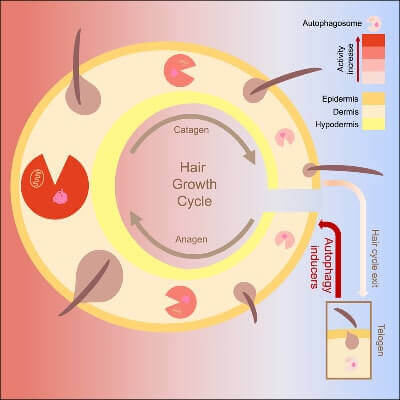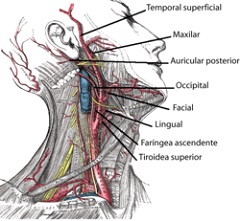
Autophagy has been in the news a lot in recent years. The word is derived from Greek and means “self-devouring” or “self-eating”. Autophagy is used to describe the human body’s process of reusing old and damaged cell parts. i.e., it is your body’s cellular recycling system.
The main reason for the increasing visibility of this word is because of the surge in popularity of caloric restriction, intermittent fasting and low carbohydrate diets. All of these can induce autophagy, as can exercise and hypoxia.
Autophagy and Hair Growth
Interestingly, autophagy can also affect hair growth positively. Perhaps not too surprising considering the number of health conditions that are impacted by inflammation and dysregulation of autophagy (and the related issue of senescent cells).
- An interesting 2019 study from University of California Los Angeles (UCLA) found that hair growth can be initiated by small molecules that activate autophagy. The scientists found that:
“Quiescent (telogen) hair follicles can be stimulated to initiate anagen and hair growth by small molecules that activate autophagy. Including the metabolites α-ketoglutarate (α-KG) and α-ketobutyrate (α-KB), and the prescription drugs rapamycin and metformin.”
- Another more recent study from 2021 found that impairment of autophagy could be a potential mechanism in androgenetic alopecia. Interestingly, RIKEN (Japan) was involved in this research.
- Yet another study from 2018 concluded that autophagy plays an essential role in human hair growth. Monasterium Laboratory was involved in this work.
Metformin, Rapamycin and Autophagy
In the first of the studies I listed on top, it is mentioned that metformin and rapamycin both impact autophagy via inhibiting mTOR and AMPK signaling. I have covered both these well known drugs in some of my past posts related to longevity and anti-aging.
While metformin is taken by diabetics, a large number of non-diabetics (including Dr. David Sinclair) who are trying to increase their healthy lifespan also take the drug. One major observational study of 200,000 patients from 2014 found that diabetics who take metformin actually outlived non-diabetics. However, this study does not imply causation. Therefore, longevity experts are eagerly awaiting results of the Targeting Aging with Metformin (TAME) trials.
Rapamycin is a potent inducer of autophagy. Many people take the drug in the belief that it counters aging in humans. Of more immediate interest is the major “Dog Aging Project“, also known as The Test of Rapamycin In Aging Dogs (TRIAD). Also of note, topical rapamycin could reverse hair greying and benefit hair growth. Perhaps even more so via microneedle delivery.
Summary
You might have no interest in such esoteric findings that are usually only tested in mouse hair initially. However, caloric restriction (under professional guidance) and exercise are almost certainly going to improve your overall health. And caloric restriction even grows hair/fur in mice (of course).
Even if you see no reduction in hair loss, experimenting with such longevity related strategies is not a bad idea. I am very averse to taking drugs, but there is a good chance that I will get on metformin in the coming years. Not yet sure about rapamycin.
